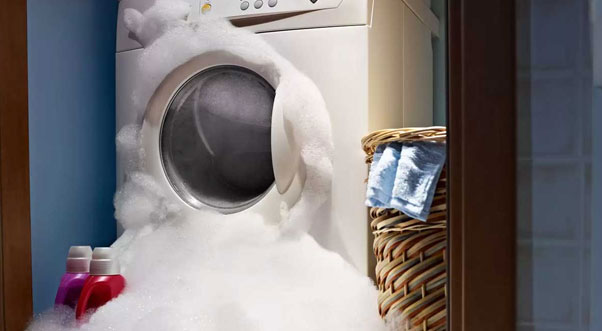
This must be addressed if there is a lot of foam from the washing machine. Soap bubbles can stick around all the equipment in a few minutes, fraught with electronic damage and a short circuit. To prevent the worst, you must act immediately: turn off the power to the machine, drain the water from it, pull things out of the drum, wipe the bubble mass, and start rinsing a couple of times. Then, be sure to identify and fix the source of the problem. Step-by-step instructions are below.
Most modern washing machines are protected from increased foaming - special sensors fix it and automatically stop washing. But sometimes, the system does not notice that the foam is climbing and continues to rotate the drum, increasing foaming. Then you need to intervene.
You must act immediately if you notice foam climbing from the hatch or powder receptacle. The first step is to assess the scale of the trouble. If too much mass covers the dashboard, you should de-energize and dry the machine and take care of the washable things. In other cases, it is recommended to follow a different instruction:
The washing machine is washed until the foam completely goes down the drain. After that, you can start looking for the cause of the problem.
Most often, increased foaming occurs due to detergent. As a rule, the problem is in the quantity or quality of the powder. So, the foam goes through the tray if:
The type of things being washed also matters. Volumetric and light products, curtains, blankets and down jackets additionally whip foam during washing. As a result, even with the standard dosage of the product, too many bubbles appear. Reducing the amount of powder or adding defoamers to the drum is necessary to avoid the consequences of soap coming out.
Foam seeps out and with problems with draining. More often, the drain hose is to blame, which becomes clogged with debris during the operation of the washing machine and does not allow the liquid to go down the drain. Clogging causes soapy water to stay in the drum longer than usual, increasing foaming. To remedy the situation, you need to clean the drain. Instructions on what to do are as follows:
To clean the groove, you must use a standard brush. It is better to tie a fishing line to it and insert it into the hose from both ends. After thoroughly washing the sleeve under the tap, if the layer of scale and plaque did not clean off manually, you must soak the hose in a warm lemon solution. The groove is lowered into the cleaner for at least 1-3 hours, after which it is washed and returned to its place. At the finish, a test wash with an idle drum start.
In the drainage system, not only the hose but also the garbage filter can become clogged. The water also does not leave the tank, and the foam does not have enough space in the drum. You need to clean the nozzle from the accumulated litter to fix the problem. The sequence is:
First, the garbage bin is cleaned of hair, threads and adhering dirt. Next, you should work with soap and a brush. If the plaque does not give in, then we turn to soak: we leave the part in a warm lemon solution for 20-60 minutes. Do not use boiling water - plastic deform at high temperatures.
Be sure to clean the filter seat. At the same time, the condition of the drain pump, snail and impeller is assessed. If necessary, everything is washed with soap and a sponge. The clean filter is returned to its place and screwed tightly into the nest. Then the test wash starts. If the foam does not come out, then the problem is fixed.
Copyright © 2020 Coimbatore Service.